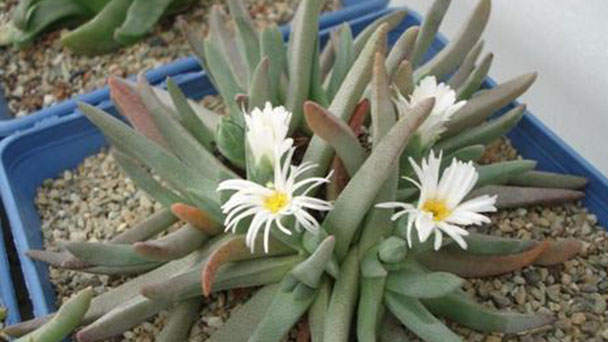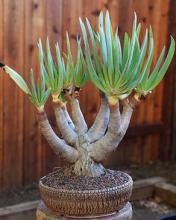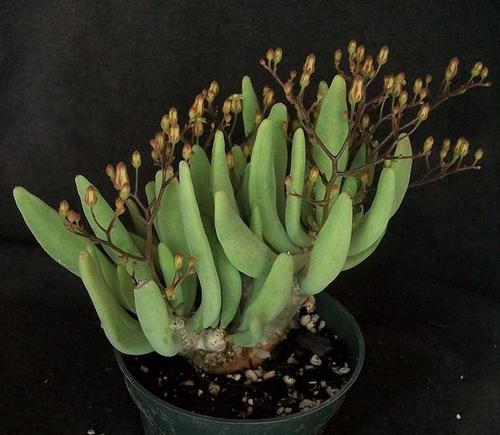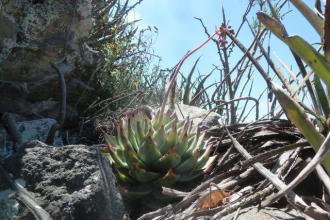Prince Albert Vygie (Ebracteola wilmaniae) profile
Written by Maggie
Feb 22 2021

Prince Albert Vygie, scientific name Ebracteola wilmaniae, is a perennial herb, very fleshy and clumpy.
Prince Albert Vygie picture

Morphological features of Prince Albert Vygie
Prince Albert Vygie (Ebracteola wilmaniae) is a perennial herb, very fleshy and clumpy. Opposite the leaf base united into a fleshy sheath, the entire opposite leaf resembles a long thin pincers. The front of the leaf is flat, the back of the leaf is rounded and convex, and the leaf epidermis is thin, with many small translucent spots. Leaves of Prince Albert Vygie (Ebracteola wilmaniae) are 4 -- 8cm tall, basally conjunctive. The young plants are solitary, and the old plants are dense. The leaves are green to grayish green, the flowers are white, about 3-5cm in diameter, and the stems are short, usually only one to two flowers per plant. The clusters of Prince Albert Vygieare (Ebracteola wilmaniae) are very spectacular. From late autumn to early spring, Prince Albert Vygie will open in the afternoon with sufficient sunshine and close at night, so that it will open and close at night for about 7 days. If it is overcast and rainy or the cultivation place has insufficient light, it is difficult to open and cross pollinate the plants. Prince Albert Vygie is easy to grow in groups.
Prince Albert Vygie propagation method
Prince Albert Vygie (Ebracteola wilmaniae) propagation can be done by sowing seeds or by dividing plants. Carnival cones are beautiful when they grow in groups.

How to grow and care for Prince Albert Vygie
Soil: Prince Albert Vygie can mix a small amount of peat with coal cinder and lay granular river sand on the soil. Planting material is mainly permeable to water and air.
Lighting and watering
Prince Albert Vygie (Ebracteola wilmaniae) not too fast, the summer must sunshade, spring is peeling, can insulate, peeling during can hydrate appropriately, the breed dry can feed water at ordinary times, otherwise the leaves grow easily either or floppy, sunburn over the summer sun, in the scattered light point that bright, ventilated, summer is also a small amount of water, more will be rotten. When the temperature comes down in autumn, the water supply can be restored step by step. In the late winter solstice and early spring, Prince Albert Vygie will have gorgeous flowers. If the Prince Albert Vygie (Ebracteola wilmaniae) is full, it does not need to be watered. If it is a little drooping on the leaves, Prince Albert Vygie (Ebracteola wilmaniae) needs to be watered immediately. In winter, it is necessary to avoid frostbite caused by too low temperature. There is no problem at minus 3 degrees Celsius when the soil in the basin is dry.
About the peeling
Prince Albert Vygie's (Ebracteola wilmaniae) peeling is when the old skin on the outside dries out slowly, providing nutrients for the new plant, whose leaves grow at the same time as the old leaves, sometimes overlapping multiple layers. Prince Albert Vygie is beautiful when they grow in flocks.
Sow a year 1 out of 2 ~ 3 two years later, if have to a lot of spread after peeling separately in the coming year will be fewer in number into 1 1, at this time of the plant can points strains, separate a clump of a cluster of small spread, so that the nutrition is to supply, separately will slowly to normal gradually, plant summer dormancy, other season to grow. Peeling period and stone flower almost, but the peeling period is longer, peeling period more bask in, less water.
Prince Albert Vygie's (Ebracteola wilmaniae) peeling is when the old skin on the outside dries out slowly, providing nutrients for the new plant, whose leaves grow at the same time as the old leaves, sometimes overlapping multiple layers. The planting material of Prince Albert Vygie is mixed with a small amount of peat from coal cinder, and the soil surface is laid with granular river sand.Planting material to permeable breathable, this variety is not too sun-resistant, summer must be shading, spring is peeling growth, can be exposed to the sun, peeling period can be appropriate hydration, this variety usually dry can water, or new leaves easily sunburn or drooping wither, dry watering, watering is not immersed in the basin.
The whole summer shading, in the bright and ventilated scattering of light, summer is also a small amount of water, more will rot. When the temperature comes down in autumn, the water supply can be restored step by step. In the late winter solstice and early spring, Prince Albert Vygie will have gorgeous flowers. If the Prince Albert Vygie (Ebracteola wilmaniae) is full, it does not need to be watered. If it is a little drooping on the leaves, it needs to be watered immediately .In winter, it is necessary to avoid frostbite caused by too low temperature. There is no problem at minus 3 degrees Celsius when the soil in the basin is dry. The difference between north and south is large, and flower friends should breed according to their own environment.

Latest Updated
- Benefits of Bugleweed - 7 Science-backed Health Benefits
- Bugleweed Dangers & Side Effects - Is It Poisonous?
- How to Plant Evergreen Trees - What You Should Know
- When to Plant Evergreens - Grow Guide for Evergreen Trees
- 12 Wonderful Evergreen Shrubs for Your Garden
- 12 Popular Evergreen Plants with Pictures for Beginners
- When And How To Prune A Lilac Bush Like a Pro
- How to Grow & Care for Lilac Vine (Hardenbergia Violacea)
- Japanese Lilac Tree (Syringa Reticulata) Care & Propagation Guide
- Shumard Oak Pros and Cons - What to Know
Popular Articles
- Winter maintenance of Antirrhinum Majus
- How to Grow Terminalia Mantaly Tree
- How to Grow and Care for Crossostephium Chinense
- How to grow Antirrhinum Majus in spring
- Peristeria Elata (Dove Orchid) Profile: Info & Care Guide
- Underwatered Snake Plant (Sansevieria Trifasciata) - Signs And How To Fix
- How to Care for Brazilian Jasmine Plant (Mandevilla Sanderi)
- How to Grow & Care for Graptopetalum Purple Delight in Summer
- Rosa Chinensis (China Rose): Plant Growing & Care Tips
- How to Care for Baby Sun Rose (Aptenia Cordifolia)